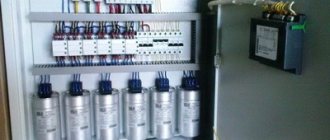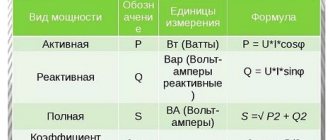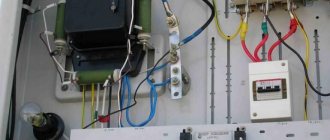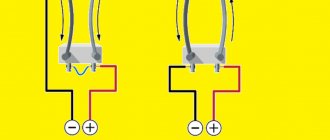Let's start with the concepts of “work” and “power”. Work is the portion of internal energy expended by a person or machine over a period of time. During such work, a person or machine warms up, releasing heat. Therefore, both internal energy and the amount of heat released or absorbed, as well as work, are measured in the same units - joules (J), kilojoules (kJ) or megajoules (MJ).
The faster work is done or heat is released, the more intensely internal energy is consumed. The measure of such intensity is power , measured in watts (W), kilowatts (kW), megawatts (MW) and gigawatts (GW). Power is the work done per unit of time (whether it is the work of a motor or the work of an electric current). Thermal power is the amount of heat transferred per unit time to the coolant (water, oil) from the combustion of fuel (gas, fuel oil) in the boiler.
Other related power units
Several other units related to kilowatt-hours are commonly used to indicate power or energy intensity or use in certain applications.
Trade unit council
(BTU) is an obsolete UK synonym for kilowatt-hour. The term comes from the name of the Board of Trade, which regulated the electric power industry until 1942, when the Department of Energy took over. This should not be confused with the British thermal unit (BTU), which is 1055 J.
In India, the kilowatt-hour is often simply called a unit
energy.
A million units, designated MU
, is a gigawatt-hour, and BU (billion units) is a terawatt-hour.
Energy in physics
Kinetic and potential energy
Kinetic energy of a body of mass m
, moving with speed
v
is equal to the work done by the force to give the body speed
v
.
Work here is defined as a measure of the action of a force that moves a body a distance s
. In other words, it is the energy of a moving body. If the body is at rest, then the energy of such a body is called potential energy. This is the energy required to maintain the body in this state.
Sir Adam Beck Hydroelectric Power Station. Niagara Falls, Ontario, Canada.
For example, when a tennis ball hits a racket in flight, it stops for a moment. This happens because the forces of repulsion and gravity cause the ball to freeze in the air. At this moment the ball has potential energy, but no kinetic energy. When the ball bounces off the racket and flies away, it, on the contrary, acquires kinetic energy. A moving body has both potential and kinetic energy, and one type of energy is converted into another. If, for example, you throw a stone up, it will begin to slow down as it flies. As this slows down, kinetic energy is converted into potential energy. This transformation occurs until the supply of kinetic energy runs out. At this moment the stone will stop and the potential energy will reach its maximum value. After this, it will begin to fall down with acceleration, and the energy conversion will occur in the reverse order. The kinetic energy will reach its maximum when the stone collides with the Earth.
The law of conservation of energy states that the total energy in a closed system is conserved. The energy of the stone in the previous example changes from one form to another, and therefore, although the amount of potential and kinetic energy changes during the flight and fall, the total sum of these two energies remains constant.
Example
To convert the specified parameters of an electrical device from kW to W, it is necessary to clarify the information from the markings on the product body, or obtain data from the equipment passport developed by the manufacturer and included in the product package.
If it is determined that the power rating of an electric kettle is 2.2 kW, this means that in watts this value will be 2.2 x 1000 = 2200 W.
In some situations, it is necessary to determine the value of the total power characteristics of household consuming devices. This need may arise in the following cases:
- to select a sufficient cable diameter when installing electrical wiring;
- when choosing safety devices that disconnect the network if the parameters exceed permissible values;
- to ensure the correct layout of household equipment in the house and proper wiring.
The calculation is performed by summing the above indicators for each of the devices. After this, the obtained value is compared with that indicated as a control value in the characteristics of the cable or safety devices, and is taken into account when locating the equipment.
For the calculation to be correct, all values must first be converted into common units of measurement from watts to kilowatts or vice versa, using the previously described method.
Expert opinion
It-Technology, Electrical power and electronics specialist
Ask questions to the “Specialist for modernization of energy generation systems”
Power in watts and kilowatts: a detailed analysis of the relationship between power values. Knowing the units of measurement will help determine the wire cross-section for electrical wiring and select suitable protective devices;. Ask, I'm in touch!
How to convert kW to kJ? Answers to questions about technology and more
Lumen/watt
Lumen/Watt is a unit of measurement used for a term called luminous efficiency. Luminous efficiency is a measurement that describes the amount of light (lumens) you get from a given amount of energy (watts). All other things being equal, you'll probably want to maximize lumens while minimizing power.
Different devices require different amounts of energy to operate. Additionally, different devices emit different amounts and quality of light for a given power. Other key considerations include:
For a deeper understanding of energy-efficient lighting solutions, we recommend contacting Svetal!
NPO Svetal is a leading manufacturer of LED lighting products, offering high-quality, innovative, environmentally friendly LED lamps at competitive prices.
What kind of lighting do you prefer?
Built-in Chandelier
LED LIGHTS
656043, Altai Territory, Barnaul, Polzunova St., 51 [email protected] - we will respond within a day
Kcal to Kilowatt hours
| 1 Kcal = 0.0012 Kilowatt hours | 10 Kcal = 0.0116 Kilowatt hours |
| 2 Kcal = 0.0023 Kilowatt hours | 20 Kcal = 0.0233 Kilowatt hours |
| 3 Kcal = 0.0035 Kilowatt-hours | 30 Kcal = 0.0349 Kilowatt hours |
| 4 Kcal = 0.0047 Kilowatt hours | 40 Kcal = 0.0465 Kilowatt hours |
Expert opinion
It-Technology, Electrical power and electronics specialist
Ask questions to the “Specialist for modernization of energy generation systems”
How many watts (W) in 1 kilowatt (kW): table and translation example Using this method, when planning a family budget, it is possible to estimate the energy consumption of the entire home, reduced to one month. Ask, I'm in touch!
Calculation examples
Now we come to the most important thing. How to convert one quantity to another using the given ratios? It's not all that complicated. Let's look at this with examples.
Example 1
Thermal power of the boiler is 30 kW. What is its equivalent power, expressed in Gcal/h?
Solution. Since 1 kW= 0.00085984523 Gcal/h, then 30 kW=30* 0.00085984523 Gcal/h=0.0257953569 Gcal/h.
Example 2
It is estimated that an air conditioner with a power of at least 2.5 kW is required to cool an office. An air conditioner with a capacity of 8000 BTU/h was selected for purchase. Is your air conditioner powerful enough to cool your office?
Solution. Since 1 BTU/h=0.2931 W, then 8000 BTU/h=2344.8 W=2.3448 kW. This value is less than the calculated 2.5 kW, so the selected air conditioner is not suitable for installation.
Example 3
The heat supply organization supplied 0.9 Gcal of heat per month. What power do you need to install a radiator so that it produces the same amount of heat per month?
Solution. Let’s assume that heat was supplied to the house evenly over one month (30 days), so the thermal power supplied by the boiler house can be found by dividing the total amount of heat by the number of hours in the month: P = 0.9 Gcal/(30*24 hours) =0.00125 Gcal/h. This power in terms of kilowatts will be equal to P=1163 kW*0.00125=1.45375 kW.
Gigacalories or kilowatts
Let us finally understand what is the difference between these units of measurement. Let us have a heating device, for example, a kettle. Take 1 liter of cold tap water (temperature t1=15°C) and boil it (heat to temperature t2=100°C). The electric power of the kettle is P=1.5 kW. How much heat will water absorb? To find out, let’s apply the formula we are familiar with, taking into account that the mass of 1 liter of water m=1 kg: Q=4183 [J/(kg*°C)]*1 kg*(100°C-15°C)= 355555 J=84922.8528 cal≈85 kcal.
How long does it take for the kettle to boil? Let all the energy of the electric current go to heating the water. Then we will find the unknown time using the energy balance: “The energy consumed by the kettle is equal to the energy absorbed by water (without taking into account losses).” The energy consumed by the kettle during time τ is equal to P*τ. The energy absorbed by water is equal to Q. Then, based on the balance, we obtain P*τ=Q. Hence the heating time of the kettle will be: τ=Q/P=355555 J/1500 W≈237 s≈4 min. The amount of heat transferred by a kettle to water per unit of time is its thermal power. In our case, it will be the value Q/τ=84922.8528 cal/237 s≈358 cal/s=0.0012888 Gcal/h.
Thus, kW and Gcal/h are units of power , and Gcal and MJ are units of heat and energy. How can such calculations be applied in practice? If we receive a receipt for payment for heating, then we pay for the heat that the supplying organization supplies us through pipes. This heat is taken into account in gigacalories, i.e. in the amount of heat consumed by us during the billing period. Should this unit be converted to joules? Of course not, because we are simply paying for a specific number of gigacalories.
However, it is often necessary to choose certain heating devices for a house or apartment, for example, an air conditioner, radiator, boiler or gas boiler. In this connection, it is necessary to know in advance the thermal power required to heat the room. Knowing this power, you can select the appropriate device. It can be indicated both in kW and in Gcal/h, as well as in BTU/h units (British Thermal Unit, h - hour). The following cheat sheet will help you convert kW to Gcal/h, kW to BTU/h, Gcal to kWh and BTU to kWh.
Memo 2
- one W=one J/s=0.2388459 cal/s=859.8452 cal/h=0.8598 kcal/h;
- one kW=one kJ/s=1000 J/s=238.8459 cal/s=859845.2279 cal/h=0.00085984523 Gcal/h;
- one MW=one MJ/s=one million J/s=1000 kW=238845.8966 cal/s=0.85984523 Gcal/h;
- one Gcal/h=one billion cal/h=1163000 W=1163 kW=1.163 MW=3968156 BTU/h;
- one BTU/h=0.2931 W=0.0700017 cal/s=252.0062 cal/h=0.2520062 kcal/h;
- one W=3.412 BTU/h, one kW=3412 BTU/h, one MW=3412000 BTU/h.
How is BTU/h determined and what is it used for? 1 BTU is the amount of heat required to warm 1 pound of water 1° Fahrenheit (°F). This unit of measurement is used primarily to indicate the heating output of installations such as air conditioners.











